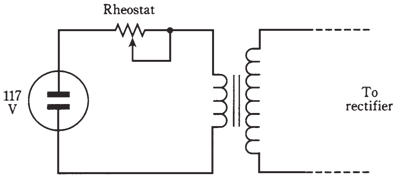Rheostat
A variable resistor can be made from a wirewound element, rather than the solid strip of material. This is termed as rheostat. A rheostat can have a rotary control or a sliding control. This depends on the nichrome wire is wound around a dough- nut-shaped form i.e. toroid or a cylindrical form i.e. solenoid.
Rheostats have inductance and resistance both. They share the advantages and drawbacks of fixed wirewound resistors.
A rheostat is not adjustable continuously, as a potentiometer is. This is because the movable contact slides along from turn to turn of wire coil. The smallest possible increment is resistance in one turn of the coil. The rheostat resistance thus adjusts in a series of small jumps.
Rheostats are used in both high power and high voltage applications. A good example is in a variable-voltage power supply. This kind of supply uses a transformer which steps up voltage from the 117-V utility mains, and diodes to change alternating current to direct current. The rheostat is placed between the utility outlet and the transformer. This results in a variable voltage at power-supply output. A potentiometer would be instantly destroyed in this application.

Figure-- Connection of a rheostat in the variable voltage power supply.